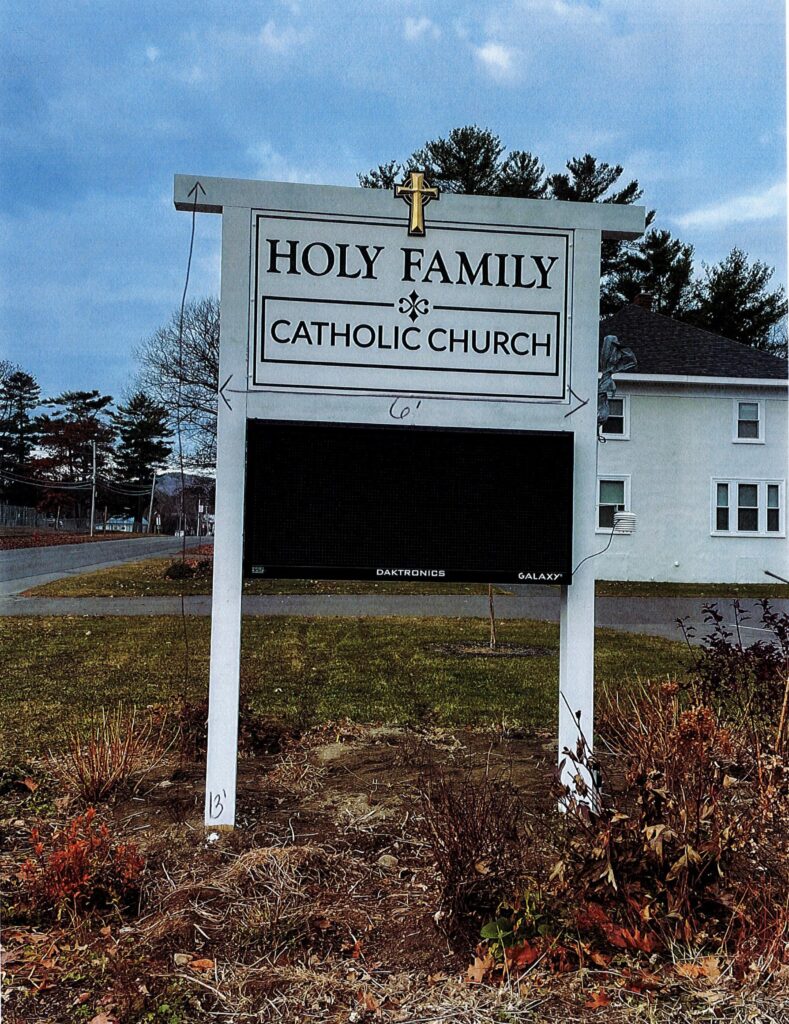
Greenville and church clash over digital sign
GREENVILLE — A Catholic church in Greenville is clashing with local officials over whether its digital sign violates a town ordinance.
Holy Family Catholic Church, along Pritham Avenue in Greenville, has put up a digital sign as part of a $3 million project to rebuild its facility over five years, which is nearly complete.
But the town erred in issuing a permit for the sign in 2017 because the digital feature was not allowed by a local ordinance, and the church made the sign considerably larger than the agreed upon size, according to Code Enforcement Officer Ronald Sarol.

CHURCH SIGN — An undated photo shows the Holy Family Catholic Church’s signage.
Displaying digital signage can be challenging for some businesses and organizations because it can conflict with town ordinances and other regulations, like those in Bangor’s historic districts before rules were relaxed in 2019. But entities like the Holy Family Catholic Church say they need the signage to advertise their services and events, especially as religious attendance is declining in Maine.
“They [the church] are still in the process of looking at the sign and seeing what they can do to bring it to compliance,” Sarol said Wednesday, but he doesn’t expect a decision until springtime.
Because the church is located in an area where the speed limit is less than 35 miles per hour, the sign cannot exceed 26 square feet, he said, citing the town’s sign ordinance. The new sign is from 40 to 42 square feet, Sarol said after measuring it.
Sarol sent a letter notifying church leaders of the violation, which they discussed in a meeting, he said. The digital portion of the sign is not yet functional because it isn’t wired, he said Wednesday.
Joe DiAngelo, co-chairperson of the church building committee, said the sign is tasteful and not obnoxious. It also provides information helpful to residents, like notice of upcoming blood drives and other events, he said.
The sign, meant to serve as a message board to churchgoers in Greenville and the surrounding community, is the crowning piece to the church’s project, which began in 2016 and involved demolishing the 100-year-old church that was there previously, DiAngelo said. The rebuild is paid in full thanks to generous donations.
The sign also allows the church to update its messages without having to send people out into dangerous winter weather to do it by hand, which led to serious falls in the past, DiAngelo said.
“We feel like everything we have done has been 100 percent transparent with our town and our community for the past five years,” he said. “Now we are trying to justify why we feel it is unfair for the town to say you did not build the exact sign that was stapled to your building permit; therefore, your sign permit is not valid.”
Town officials were invited to tour the construction site and the church worked closely with Jack Hart, a former code enforcement officer who issued the permit, DiAngelo said. He argued the permit is grandfathered, and no one was informed that it had an expiration date, so the church is not subject to certain regulations outlined in the town’s sign ordinance.
Removal of the sign is unwarranted, he said, and would violate the church’s vested rights and cause undue hardship, referring to the town’s code.
The church met with Peter Leathers, also a former officer, this year to confirm it was still in good standing with its sign permit, and he said it was, DiAngelo said. Soon after, the church sent its final installment of about $7,000 toward the $14,300 sign, he said.
“[Later], we were told, if we allow you to do this, others will want to do this and we’ll have signs like this all over town,” he said, recalling a conversation between a church building committee member, the town manager and Sarol.
The sign, made of 100-percent recycled plastic with minimal impact to dark skies, benefits the entire community, DiAngelo argued. The digital portion is black with amber-colored text, and it does not feature flashing colors and lights that would be distracting, he said.
The church has a right to rely on the permit issued in 2017, one planning board member said, and her understanding was that there is no expiration date, which Sarol later confirmed. But the sign far exceeds the size that was permitted, and it’s unclear why it was expanded so greatly, she said.
There was some debate between town officials and the church over the sign’s size and how measurements are taken, along with why the church never revised its permit if those involved in the project knew it would be bigger than expected. Nothing in the paperwork indicated that the permit should be revised, DiAngelo said, arguing the town was focused on a small technicality.
Planning board members discussed how to move forward, and options came down to the church reducing its sign square footage or going to the town’s board of appeals to request a variance that would keep the town’s ordinance intact.
The church is willing to work with town officials, DiAngelo said, pointing out that it has always been an advocate for bettering Greenville.
Piscataquis Observer staff writer Stuart Hedstrom contributed to this story.